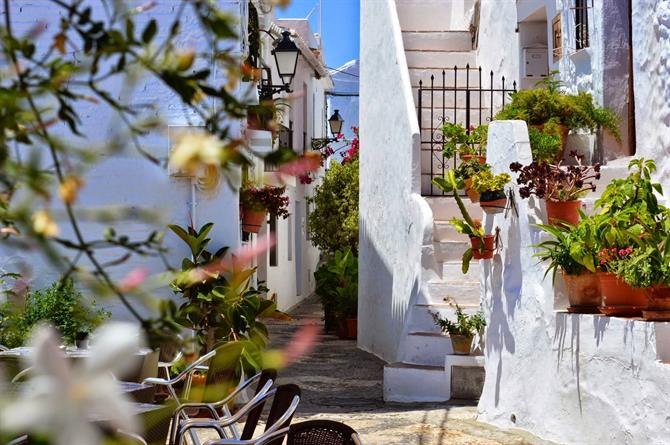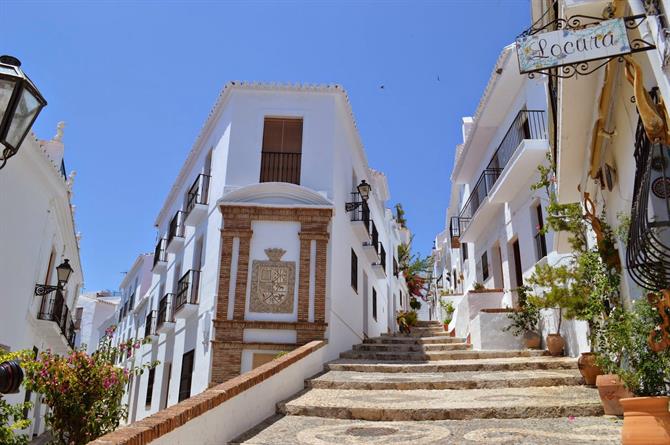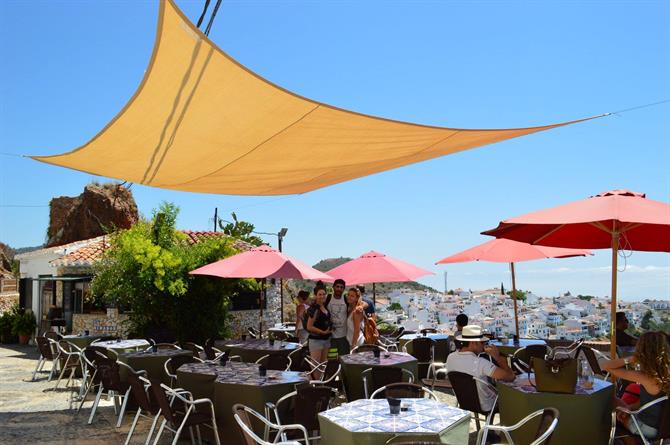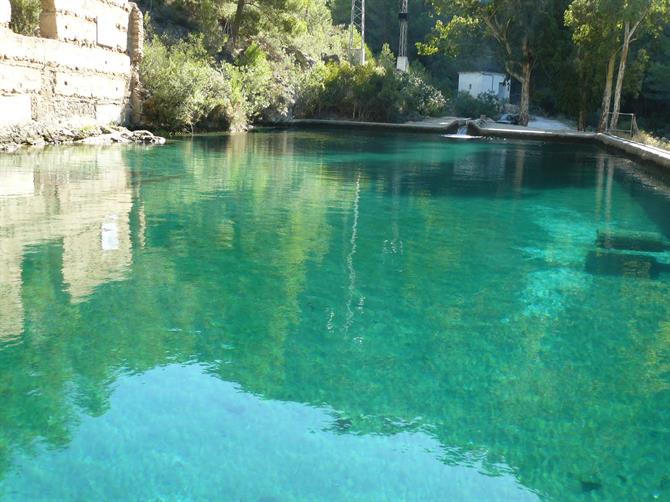The village of Frigiliana is situated six-kilometres north of Nerja and just over fifty kilometres from Málaga. Villages on the Costa del Sol don’t come much more picturesque than Frigiliana. This exceptionally beautiful white-washed village is truly one of a kind.
A maze of cobbled streets, with meticulously maintained whitewashed houses, that provide a stunning contrast against the blue skies and red slate roofs. The colourful plant pots brimming with bougainvillaea, lavender and jasmine all add an extra dash of colour to this enchanting scene.
As you wander up the hillside through the pedestrianised cobbled streets, past the white houses with doors painted an array of pastel colours, past tiny nooks and crannies and viewpoints that offer glimpses of the surrounding countryside and the coast below, you can fully understand why Frigiliana is considered by many to be one of the most beautiful villages in Andalusia. A village that has consistently won awards to that effect. Including being voted as the ‘prettiest village in Andalusia’ by the Spanish tourism authority.
Let's take a look.
About Frigiliana
The village can be divided into two. The newer, lower, section and the older Morisco-Mudéjar neighbourhood, the upper section. The upper section is the place to be.
Wandering the streets is a joy. You feel as if you are taken back in time, back to a land of Moorish Kingdoms and the Reconquista, to a place that feels remarkably like one of the villages in the neighbouring Riff mountains of Morocco. The whole feel and atmosphere of Frigiliana is remarkable.

A labyrinth of narrow and winding streets, each one hiding something that is just waiting to be explored. Be warned, however, Frigiliana is built on a mountainside and these streets are steep. Very steep in places.
Situated at three hundred metres above sea level, the views from Frigiliana are spectacular. On a clear winter’s day, the North African coastline is often visible and the views of Nerja and the surrounding countryside don’t come much better than those on offer from Frigiliana.
Historical and cultural highlights in Frigiliana
- Points of historical interest include the Fuente Vieja (old fountain), the San Antonio church, the Real Expósito (ancient silo), Santo Cristo de la Caña chapel and the Renaissance Palace of the Counts of Frigiliana.

- The Casa Solariega de los Condes (the ancestral home of the counts), also known as the El Ingenio (the mill) was built in the late 16th century for the Manrique de Lara family. They planted a sugar cane plantation and established a sugar mill. The building still houses a molasses factory, the Ingenio Nuestra Señora del Carmen— the last of its kind in Europe.
- The Casa del Apero was built in the early XVII Century and now houses the Tourist Office, Municipal Library, all of Frigiliana’s historical archives and the Historical Museum. The museum is worth having a look, being the first archaeological museum in the Axarquía.
- El Torreón is another interesting spot. Situated in the old Mudéjar neighbourhood, just off Calle Real. The site of an old granary, it is now part of a house. The picturesque courtyard is accessed via a plant-filled archway, signposted ‘El Torreón.’
- A visit to the remains of the old Moorish castle at the top of the village. Not much is left of the castle, having been destroyed when the Moors were expelled, but the views are spectacular.
- The 3 Cultures Festival which is celebrated on the last week of August is now Frigiliana’s largest event.
- Frigiliana’s Patron Saint is San Sebastian with celebrations taking place on the 20th of January. Another big event on Frigiliana’s yearly calendar is the 13th of June, during the local Feria, when homeage is paid to San Antonio de Padua.
Things to do in Frigiliana
- Wandering the streets of the award-winning Mudéjar neighbourhood.
- Lunch or tapas with a view. Many of the restaurants and bars have rooftop terraces overlooking the village and the valley below. Recommended are La Taberna del Sacristan (Plaza de la Iglesia, 3), The Garden Restaurant (Calle Santo Cristo s/n - thegardenfrigiliana.com) offers fantastic views and dishes. For tapas, Restaurante Al Fuente (Calle Real 32) and the cakes at La Tienda (Calle de la Iglesia, 7) are delicious.

- Following the plaques. There are twelve ceramic plaques that are situated throughout the old section of the village. They tell the story of the Moorish uprising and the last battles that were fought in the area.
- The bohemian atmosphere of the village has attracted some famous artists and photographers over the years, including Arne Haugen Sørensen, Klaus Hinkel, Penelope Wurr and Miro Slavin. There are regular exhibitions in the Casa del Apero and in private galleries.
- Getting out into nature. Frigiliana is a great base from which to explore the surrounding Sierra de Tejada Almijara natural park. Hiking doesn't get much better than this. John Keo (+34 647273502) is the man to speak to about local walks.
- Exploring the Rio Higueron. The Higueron river is quieter than the neighbouring Rio Chillar in Nerja. There are some fantastic spots for picnics and hiking.
- Horseriding is popular in the area. Donna from los-olivillos.com comes recommended.

- Pozo Batan Alberca - Frigiliana's natural swimming pool. swimming is not officially allowed, although both locals and visitors do swim here. Take care if planning to swim, particularly with children. Jumping from the from the surrounded structures is not recommended (despite what you see in the video above).
- Visiting the lost village of Acebuchal should be high on any visitors list to the area.
- Visting the local market - Frigiliana's market days are Thursdays and Sundays. Always a great source for local produce and specialities.
Getting to Frigiliana
Frigiliana is situated just above Nerja. Follow the A7/E15 until you reach the exit for Nerja and Frigiliana, exit number 292. Go leftwards over the roundabout and keep going straight over the next one, taking the MA-5105 into the mountains (you can't miss it). This road winds round and climbs the mountain eventually reaching Frigiliana.
There is a large municipal car park at the entrance to the village. The best place to park. Do not attempt driving around the centre village. Several roads are pedestrianised and those that aren't are very steep and narrow. Leave the driving to the locals.
There are regular buses leaving from Nerja to Frigiliana. Journey time is about 15 minutes and costs around one euro.
A taxi ride from Nerja to Frigiliana should cost between 10-15€ depending on the time of day.
